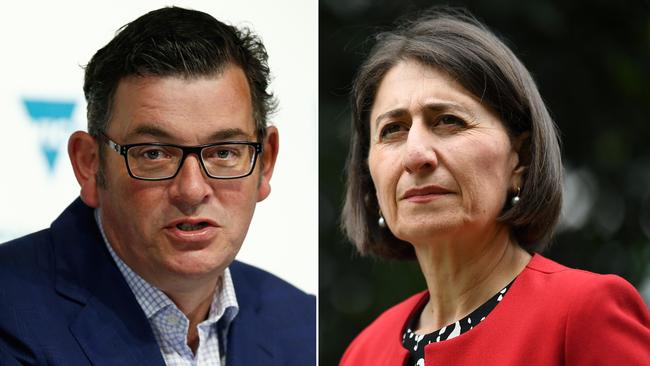Victoria, NSW lose AAA credit rating as S&P downgrades over weaker outlook and debt burdens
Victoria and NSW have lost their rolled-gold AAA credit ratings, with S&P Global issuing downgrades that also cast a cloud over the federal government’s prized AAA rating.

Business
Don't miss out on the headlines from Business. Followed categories will be added to My News.
Victoria and NSW have lost their prized AAA credit ratings, with ratings agency S&P Global downgrading both states on Monday in moves that put a cloud over the federal government’s own AAA rating.
S&P Global cut its long-term rating on Victoria by two notches to “AA/Stable” from “AAA/Watch Negative” citing a weaker fiscal outlook. The prolonged lockdown in the state due to two coronavirus outbreaks this year has led to more significant effect on the state’s economy than elsewhere in Australia and the government’s path to fiscal repair would be more challenging, the international ratings agency said.
But in something of a surprise, NSW also lost its coveted AAA rating. The state’s long-term issuer credit rating fell one notch to AA+/Stable from AAA/Negative as the coronavirus pandemic slashed revenue projections and fueled public spending on NSW’s large infrastructure program.
NSW treasurer Dominic Perrottet played-down the ratings downgrade, saying that NSW had experienced “challenge upon challenge in 2020”.
He said “drought, bushfires and then COVID-19” have all “hurt our revenue base”.
Mr Perrottet said in addition to lower revenue, the government had spent $29bn on economic stimulus and support in response to the COVID crisis.
He noted that ratings agency Moody’s reaffirmed the AAA credit rating last week.
“The ratings agencies noted NSW’s history of sound financial management, our willingness to tackle COVID-19 head-on when it mattered, and a strong commitment to return the balance sheet to a sustainable footing,” he said.
“Our economic response has been about creating as many jobs as possible, supporting businesses through this time and maintaining record level of investment in infrastructure.
“We have begun to see green shoots as we recover from the first recession in a generation and our priority is to return people to work and the economy to solid and sustained growth, with a medium term focus on fiscal repair of the balance sheet,” he said.
The stable outlook reflects S&P’s expectation that NSW’s budgetary performance will improve during the next few years as the economy climbs out of a Covid-19-induced recessionBut new borrowings will see NSW’s debt rise substantially to levels consistent with AA+ rated peers.
Meanwhile S&P said Victoria’s operating and after-capital account deficits and debt burden had “deteriorated sharply” as a result of the coronavirus pandemic, mobility restrictions and a big-spending budget.
Victoria’s debt reached about 200 per cent of operating revenue in 2023, up from 70 per cent in 2019. Victoria’s after-capital account deficit was expected to remain large and debt levels were expected to be elevated for many years, S&P said.
S&P also removed Victoria from CreditWatch negative and said its outlook was now stable.
Before this downgrade, Victoria was one of the few state governments globally with a AAA rating.
Appearing at a parliamentary committee meeting last week, RBA governor Philip Lowe said the prospect of Victoria losing its AAA credit rating “doesn’t concern me”, and maintaining the top debt grade from global agencies had “more political symbolism than economic importance”.
Deloitte Access Economics Partner Chris Richardson said the NSW downgrade was not a cause for any concern.
The respected economist said NSW residents “shouldn’t lose any sleep” over the credit ratings, which are designed to indicate “how likely it is” that a government will be able to repay debt.
Mr Richardson said credit ratings can be useful in times of regular economic activity but are not effective in measuring success amid the COVID crisis because governments need to borrow money to protect their citizens.
“I would take it as applause, rather than a problem,” he said.
While credit ratings can impact interest rates for government debt, Mr Richardson said the impact to NSW will be negligible.
“If you had to pick governments around the world that you thought would really pay money back, you’d start in Australia before you started almost anywhere else,” he said.
S&P said NSW would post historically large operating and after capital-account deficits this fiscal year, pushing debt sharply higher even if prospective asset sales eventuate.
Speaking at a parliamentary committee hearing on Wednesday, Dr Lowe endorsed the decision by states and territories to incur massive debt and deficits to cushion the economic blow from the COVID-19 recession.
He said states collectively had recorded budget deficits equivalent to 5 per cent of their total output, and that this was “exactly the right thing to do” — even if it resulted in a downgrade from one of the global ratings agencies.
“AAA credit ratings have more political symbolism than economic importance,” Dr Lowe said. “What is of more concern is that people don’t have jobs.”
He said record state debt levels were manageable at record low borrowing costs. “What I want to see is strong public finances in Australia, and I think we have that and we are going to continue to have that,” Dr Lowe said.
While he reiterated that record state debt levels were manageable at record low borrowing costs, he said it would “not be prudent to bake in high levels of expenditure indefinitely”.
More to come



